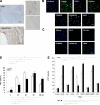c-Jun regulates shear- and injury-inducible Egr-1 expression, vein graft stenosis after autologous end-to-side transplantation in rabbits, and intimal hyperplasia in human saphenous veins
- PMID: 19940138
- PMCID: PMC2823545
- DOI: 10.1074/jbc.M109.078345
c-Jun regulates shear- and injury-inducible Egr-1 expression, vein graft stenosis after autologous end-to-side transplantation in rabbits, and intimal hyperplasia in human saphenous veins
Erratum in
- J Biol Chem. 2013 Nov 1;288(44):31918
Retraction in
-
Withdrawal: c-Jun regulates shear- and injury-inducible Egr-1 expression, vein graft stenosis after autologous end-to-side transplantation in rabbits, and intimal hyperplasia in human saphenous veins.J Biol Chem. 2018 Dec 28;293(52):20307. doi: 10.1074/jbc.W118.007069. J Biol Chem. 2018. PMID: 30593535 Free PMC article. No abstract available.
Abstract
Coronary artery bypass graft failure represents an unsolved problem in interventional cardiology and heart surgery. Late occlusion of autologous saphenous vein bypass grafts is a consequence of neointima formation underpinned by smooth muscle cell (SMC) migration and proliferation. Poor long term patency and the lack of pharmacologic agents that prevent graft failure necessitate effective alternative therapies. Our objective here was to evaluate the effect of targeted inhibition of the bZIP transcription factor c-Jun on intimal hyperplasia in human saphenous veins and vein graft stenosis after autologous end-to-side transplantation. DNAzymes targeting c-Jun attenuated intimal hyperplasia in human saphenous vein explants. Adenovirus-forced c-Jun expression stimulated SMC proliferation, proliferating cell nuclear antigen, and MMP-2 expression. c-Jun DNAzymes abrogated Adeno-c-Jun-inducible SMC growth and wound repair and reduced intimal thickening in jugular veins of New Zealand white rabbits 4 weeks after autologous end-to-side transplantation to carotid arteries. Conversely, in a DNAzyme-free setting, Adeno-c-Jun potentiated neointima formation in the veins compared with Adeno-LacZ. Inducible c-Jun expression is ERK1/2- and JNK-dependent but p38-independent. Injury- and shear-inducible c-Jun controls early growth response-1. These data demonstrate that strategies targeting c-Jun may be useful for the prevention of vein graft stenosis. Control of one important shear-responsive transcription factor by another indicates the existence of transcriptional amplification mechanisms that magnify the vascular response to cell injury or stress through inducible transcriptional networks.
Figures








Similar articles
-
Inhibition of vein graft stenosis with a c-jun targeting DNAzyme in a cationic liposomal formulation containing 1,2-dioleoyl-3-trimethylammonium propane (DOTAP)/1,2-dioleoyl-sn-glycero-3-phosphoethanolamine (DOPE).Int J Cardiol. 2013 Oct 9;168(4):3659-64. doi: 10.1016/j.ijcard.2013.05.092. Epub 2013 Jul 22. Int J Cardiol. 2013. PMID: 23886527 Free PMC article.
-
Early growth response gene-1 decoy oligonucleotides inhibit vascular smooth muscle cell proliferation and neointimal hyperplasia of autogenous vein graft in rabbits.Interact Cardiovasc Thorac Surg. 2015 Jul;21(1):50-4. doi: 10.1093/icvts/ivv066. Epub 2015 Mar 27. Interact Cardiovasc Thorac Surg. 2015. PMID: 25820759
-
Use of Brilliant Blue FCF during vein graft preparation inhibits intimal hyperplasia.J Vasc Surg. 2016 Aug;64(2):471-478. doi: 10.1016/j.jvs.2015.02.028. J Vasc Surg. 2016. PMID: 27763268 Free PMC article.
-
Acute shear stress and vein graft disease.Int J Biochem Cell Biol. 2022 Mar;144:106173. doi: 10.1016/j.biocel.2022.106173. Epub 2022 Feb 10. Int J Biochem Cell Biol. 2022. PMID: 35151879 Review.
-
Coronary artery bypass graft: why is the saphenous vein prone to intimal hyperplasia?Can J Physiol Pharmacol. 2014 Jul;92(7):531-45. doi: 10.1139/cjpp-2013-0445. Epub 2014 May 16. Can J Physiol Pharmacol. 2014. PMID: 24933515 Review.
Cited by
-
Fluid flow mechanotransduction in vascular smooth muscle cells and fibroblasts.Ann Biomed Eng. 2011 Jun;39(6):1608-19. doi: 10.1007/s10439-011-0309-2. Epub 2011 Apr 9. Ann Biomed Eng. 2011. PMID: 21479754 Free PMC article. Review.
-
Early growth response-1 in the pathogenesis of cardiovascular disease.J Mol Med (Berl). 2016 Jul;94(7):747-53. doi: 10.1007/s00109-016-1428-x. Epub 2016 Jun 1. J Mol Med (Berl). 2016. PMID: 27251707 Review.
-
Egr-1 mediates leptin-induced PPARγ reduction and proliferation of pulmonary artery smooth muscle cells.Mol Biol Cell. 2018 Feb 1;29(3):356-362. doi: 10.1091/mbc.E17-03-0141. Epub 2017 Dec 6. Mol Biol Cell. 2018. PMID: 29212876 Free PMC article.
-
Transfected early growth response gene-1 DNA enzyme prevents stenosis and occlusion of autogenous vein graft in vivo.Biomed Res Int. 2013;2013:310406. doi: 10.1155/2013/310406. Epub 2013 Mar 17. Biomed Res Int. 2013. PMID: 23586030 Free PMC article.
-
Promoter Usage and Dynamics in Vascular Smooth Muscle Cells Exposed to Fibroblast Growth Factor-2 or Interleukin-1β.Sci Rep. 2018 Sep 3;8(1):13164. doi: 10.1038/s41598-018-30702-4. Sci Rep. 2018. PMID: 30177712 Free PMC article.
References
-
- Wang X. L., Tam C., McCredie R. M., Wilcken D. E. (1994) Circulation 89, 1974–1981 - PubMed
-
- Goldman S., Zadina K., Moritz T., Ovitt T., Sethi G., Copeland J. G., Thottapurathu L., Krasnicka B., Ellis N., Anderson R. J., Henderson W. (2004) J. Am. Coll. Cardiol. 44, 2149–2156 - PubMed
-
- Fitzgibbon G. M., Kafka H. P., Leach A. J., Keon W. J., Hooper G. D., Burton J. R. (1996) J. Am. Coll. Cardiol. 28, 616–626 - PubMed
-
- The Post Coronary Artery Bypass Graft Trial Investigators (1997) N. Engl. J. Med. 336, 153–162 - PubMed
-
- Topol E. J., Serruys P. W. (1998) Circulation 98, 1802–1820 - PubMed
Publication types
MeSH terms
Substances
LinkOut - more resources
Full Text Sources
Research Materials
Miscellaneous

